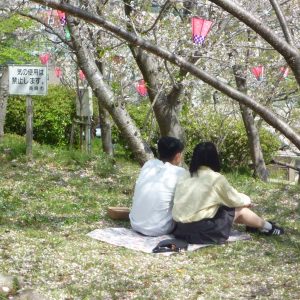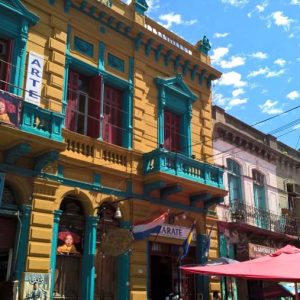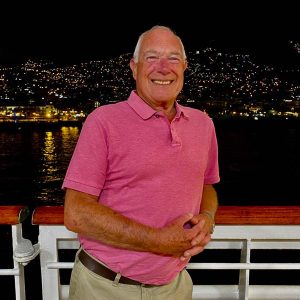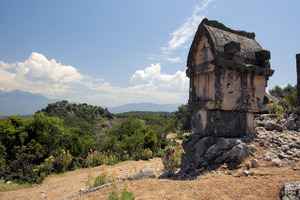 The ancient Lycians were a very unusual people. From around 3000BC they lived in southern Turkey in a uniquely peaceable fashion. Unlike their warring neighbours, they formed the first known democratic union of 23 cities (long before democracy had developed in Greece) and women had a remarkable position in society at the time, too. It is thought that Lycians used their mothers’ names rather than their fathers’ and it was a woman who presided at the national assembly every year in the city of Letoon. The founding fathers in the US were so impressed by them, they studied Lycian democracy when writing their own constitution.
The ancient Lycians were a very unusual people. From around 3000BC they lived in southern Turkey in a uniquely peaceable fashion. Unlike their warring neighbours, they formed the first known democratic union of 23 cities (long before democracy had developed in Greece) and women had a remarkable position in society at the time, too. It is thought that Lycians used their mothers’ names rather than their fathers’ and it was a woman who presided at the national assembly every year in the city of Letoon. The founding fathers in the US were so impressed by them, they studied Lycian democracy when writing their own constitution.
The Lycians left a number of cities and you can still see their remains today – Telmessos, Xanthos, Pinara, Tlos, Cadianda and Patara. Later cultures (mainly Greek and Roman) moved in and made their own additions. However, there is one aspect of Lycian architecture that was unique to them and stands today much as it did when first built. The Lycian tombs are carved into rock on the cliff faces of this mountainous region of Turkey and usually have a wonderful view of the Med (the Lycians were clearly keen on a pleasant afterlife).
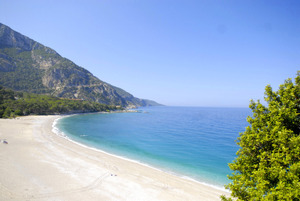 This area is known as the Turquoise Coast and it certainly lives up to its name, the sea many shades of blue and a coastline of coves and long sandy beaches (16km at Patara), rugged cliffs and gorges and islands dotted nearby. It is perhaps this very ruggedness that has kept resorts on the comparatively small side and (as long as you avoid Marmaris) quiet. Many people arrive here by yacht and, if you don’t, you should definitely spend a day on the sea visiting the coves and islands all along the coast. You can take a boat from Fethiye then spend a relaxing evening in one of its bars or restaurants that overlook the promenade and the beach. If you’re feeling adventurous and would like a bird’s eye view of this amazing coastline, you can even tandem paraglide off the Babadag mountains to land on the sand – it’s rated as one of the best aerial views in the world.
This area is known as the Turquoise Coast and it certainly lives up to its name, the sea many shades of blue and a coastline of coves and long sandy beaches (16km at Patara), rugged cliffs and gorges and islands dotted nearby. It is perhaps this very ruggedness that has kept resorts on the comparatively small side and (as long as you avoid Marmaris) quiet. Many people arrive here by yacht and, if you don’t, you should definitely spend a day on the sea visiting the coves and islands all along the coast. You can take a boat from Fethiye then spend a relaxing evening in one of its bars or restaurants that overlook the promenade and the beach. If you’re feeling adventurous and would like a bird’s eye view of this amazing coastline, you can even tandem paraglide off the Babadag mountains to land on the sand – it’s rated as one of the best aerial views in the world.
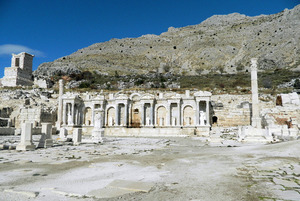 It’s almost as exhilarating – and you certainly get jaw-dropping views – if you walk along the Lycian Way. You can find different levels of Lycian Way – some are down by the sea, others higher up in the mountains – and the walks around Faralya where I stayed are particularly fine. About 15 minutes’ drive from Fethiye – mostly uphill! – it is a quiet village surrounded by pine forest and filled with butterflies and dragonflies. You could easily spend a week walking here every day (avoiding the hot summer months) and take in coves and seashores, rare wild flowers and wildlife (I met a wandering tortoise), natural springs and pools for swimming and Butterfly Valley, a steep-walled canyon leading to a cove with a restaurant waiting to give you a cold drink.
It’s almost as exhilarating – and you certainly get jaw-dropping views – if you walk along the Lycian Way. You can find different levels of Lycian Way – some are down by the sea, others higher up in the mountains – and the walks around Faralya where I stayed are particularly fine. About 15 minutes’ drive from Fethiye – mostly uphill! – it is a quiet village surrounded by pine forest and filled with butterflies and dragonflies. You could easily spend a week walking here every day (avoiding the hot summer months) and take in coves and seashores, rare wild flowers and wildlife (I met a wandering tortoise), natural springs and pools for swimming and Butterfly Valley, a steep-walled canyon leading to a cove with a restaurant waiting to give you a cold drink.
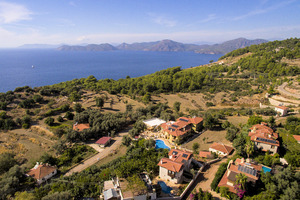 I stayed at the Mandarin and Mango Hotel in Faralya where owner Ghislain is a keen walker and very happy to be a guide. It’s in a lovely spot with a lush garden, a big pool and even bigger rooms complete with a quirky rustic kind of luxury. My room had a fireplace for winter, a four-poster bed, a Jacuzzi big enough for six in the sitting room and Turkish rugs scattered over the floor. Most people come for B&B (breakfast is delicious and Mediterranean) or half-board (five course dinners where the wine flows) and you can also join one of Ghislain’s courses – he has not just walking weeks, but cookery courses, photography and Argentine tango lessons, too. They pride themselves here on the tranquillity of the surroundings (and there are no children under 12).
I stayed at the Mandarin and Mango Hotel in Faralya where owner Ghislain is a keen walker and very happy to be a guide. It’s in a lovely spot with a lush garden, a big pool and even bigger rooms complete with a quirky rustic kind of luxury. My room had a fireplace for winter, a four-poster bed, a Jacuzzi big enough for six in the sitting room and Turkish rugs scattered over the floor. Most people come for B&B (breakfast is delicious and Mediterranean) or half-board (five course dinners where the wine flows) and you can also join one of Ghislain’s courses – he has not just walking weeks, but cookery courses, photography and Argentine tango lessons, too. They pride themselves here on the tranquillity of the surroundings (and there are no children under 12).
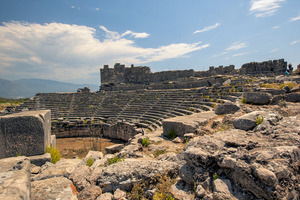 Visitors are starting to return to Turkey after a few lean years and it’s well worth the journey. The Turquoise Coast in particular is a delightful spot – restful and invigorating in equal measure and far away from the tourist traps.
Visitors are starting to return to Turkey after a few lean years and it’s well worth the journey. The Turquoise Coast in particular is a delightful spot – restful and invigorating in equal measure and far away from the tourist traps.

